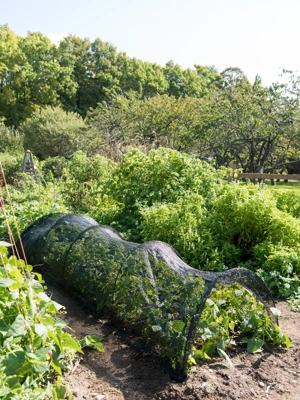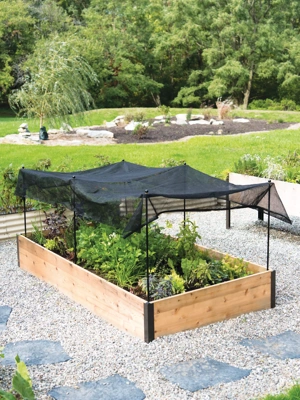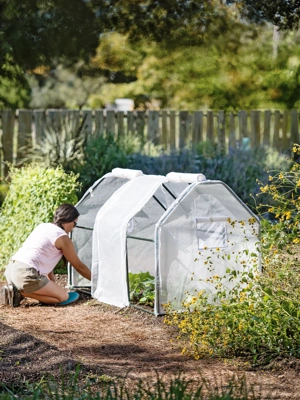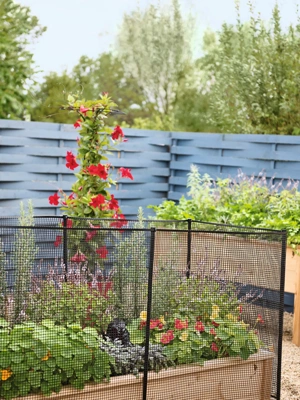Gardening Techniques for Dry Weather
 Shade covers help crops thrive during summer heat.
Shade covers help crops thrive during summer heat.In times of drought, it can be difficult to make sure plants get the water they need to survive, much less thrive. With wells running dry, reservoirs running low, and water bans in effect in many areas, we have no choice but to minimize the amount of water we give our plants. So how can we keep them happy and healthy while using little additional water?
Try thinking like a plant. If you understand how a plant gets and uses water, it's a lot easier and actually kind of fun, to figure out to how create and maintain a water-efficient garden.
All About Roots
Most plants absorb very little moisture through their leaves. Almost all the water they need has to get absorbed through their roots. So the more roots they have, the better equipped they are to find and absorb moisture. A well-developed root system with lots of little sponge-like root hairs is a plant's best insurance for survival in drought conditions.
For a plant to develop a good root system, the roots need to be able to push out into the soil. And to do that, they need to be working in a loose, friable soil—not one that is hard and compacted. Gardeners can help create good conditions for root growth by breaking up hard-packed soil with a fork, and most of all, by adding organic matter. Mixing organic matter in with native soil particles loosens up the soil and makes it much easier for roots to stretch out in all directions.
Organic matter—such as compost, peat moss, and shredded leaves—works in two other important ways to help roots access moisture. Adding these materials will make your soil more porous, so water that's applied to the soil surface won't run off but rather will move down into the root zone.
Soil that contains a large amount of organic matter can also retain much more moisture. Imagine pouring a cup of water over a pile of small stones. Now think about pouring a cup of water on a clump of moss. When water is applied to soil with lots of organic matter in it, the water is held in place so it's available to plant roots when they need it. One-hundred square feet of good, loamy soil can absorb about 90 gallons of water, whereas 100 square feet of sand can only absorb 60 gallons.
One last note about roots. Absorbing moisture is the task of the youngest, most tender part of a plant's root system—the growing root tips and root hairs. When moisture conditions alternate radically between wet and dry, these root hairs get stressed and damaged. Covering the soil surface with a thick layer of mulch reduces water loss due to evaporation, and just as importantly, helps maintain a consistent moisture level in the soil to keep delicate root hairs healthy.
All About Leaves
Plants don't absorb very much water through their leaves, but they do lose water through their leaves. In fact, 98% of the water absorbed by a plant goes out through the microscopic pores (called stomates) on the plant's leaves. This "exhaling" of water vapor, called transpiration, is a necessary part of the plant's metabolic process of absorbing soil nutrients. Transpiration also helps plants cool themselves in hot weather.
Sun Protection
That said, there are several ways to minimize the amount of moisture your plants lose through their leaves. Start by protecting them from excessive sun and heat. Late-day sun is especially hot, so it's a good idea to provide your plants with a little afternoon shade. Make use of the trees in your yard, put up a lattice roof over your deck plants, or just plant wisely so tall plants provide some shade for shorter plants.
Remember that droopy leaves on a hot afternoon are not always cause for alarm. In hot sunlight, some plants are able to close their stomata and reduce transpiration. It's a natural defense mechanism. Once the sun goes down and the air temperature begins to cool, the plants will resume their normal functions and the leaves will perk up.
 shade net protects a crop of greens.
shade net protects a crop of greens.Wind Protection
Another important way to reduce moisture loss through your plants' leaves is to protect them from wind. My garden is in a very windy location and I use a number of techniques to calm it. In the springtime, newly seeded beds get watered once, and are then covered with garden fabric. This cover keeps the soil surface from drying out and also protects the newly emerging plants from being battered by the wind. Young plants are especially vulnerable to moisture loss because they haven't established enough of a root system to keep themselves hydrated. So in my garden, I almost always cover new transplants with garden fabric for a week or so. Once their roots have taken hold, the cover can be removed.
 Tomato plants getting wrapped in a protective layer of All-Purpose Garden Fabric.
Tomato plants getting wrapped in a protective layer of All-Purpose Garden Fabric.For the last couple of years, I have also been using garden fabric to wrap all four sides of my tomato cages as well as the mini-cages that I use for eggplant. The plants love this protection from the wind, and they thrive with very little additional water.
Flowers appreciate wind protection as well. At my house, the prevailing wind is from the southwest, so I installed a 3-foot picket fence along the western side of my cutting garden. Like most windbreaks, this fence protects an area about one to three times its height. (At three feet high, it shields about six to nine feet of the garden that lies to the northeast of it.) I find this wind-protected part of the garden rarely needs watering.
I have also planted shrubs and trees to create windbreaks in various places around the yard. In the perennial garden, I use tall, sturdy plants such as echinops and garden phlox to shield more tender plants from wind. In the Native Americans' traditional three sisters garden, they used tall corn plants to provide wind and sun protection for the squash and beans growing below. I do the same in my own vegetable garden, using the tomatoes to shield the beans, and the sunflowers to shield the cucumbers.
Last updated: 07/12/2023
Print this Article:
Related items
Get the Dirt
Stay up to date on new articles and advice. Please fill out the information below.











